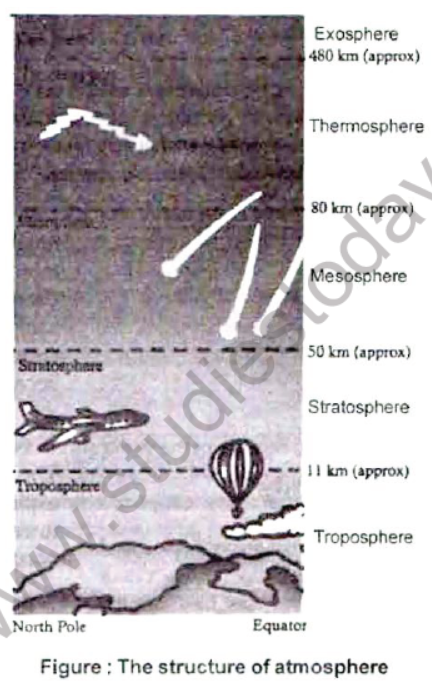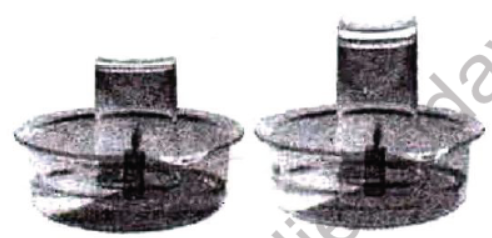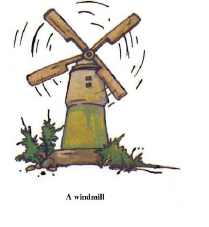AIR
INTRODUCTION
All
living things require air. We have not seen air but we must have felt
its presence in so many ways. For example, when the leaves of the trees
rustle or the clothes hanging on a clothes line sway.
IS AIR PRESENT EVERYWHERE AROUND US?
Air
is present everywhere around us. It fills all the empty space . It has
no colour and one can see through it. It is transparent.
The presence of air can be felt by a simple experiment.
Activity :
Take
an empty glass bottle. Turn it upside down. Now dip the open mouth of
the bottle into a bucket filled with water as shown in the figure. We
observe that water does not enter the bottle.
Now
tilt the bottle slightly. We observe that now water enters the bottle
and we can see bubbles coming out of the bottle with a bubbly sound.
This shows that air was present in the bottle. The bottle was not empty
at all. In fact it was filled completely with air even when it is upside
down. That is why water does not enter the bottle when It is pushed in
an inverted position as there was no space for air to escape.
When
the bottle was tilted the air was able to come out in the form of
bubbles and water filled up the empty space that the air has occupied.
WHAT IS AIR MADE UP OF ?
Air
is a mixture of several gases, water vapour and fine dust particles. A
human being respires about 22,000 times everyday and takes in about 16
kg of air. Air contains mainly nitrogen, oxygen and smaller amounts of
argon, carbon dioxide, water vapours and traces of helium, neon, krypton
and xenon.
ATMOSPHERE
The
transparent , thick and invisible envelope of air surrounding us is
called atmosphere. It consist of a uniform mixture of permanent gases
called dry air and varying amounts of other materials including organic
and inorganic impurities such as smoke, pollen grains and dust
particles.
The atmosphere is divided in various layers to facilitate the study of it.
The
different layers of atmosphere (starting from the surface of earth) are
troposphere, stratosphere, mesosphere, thermosphere and exosphere.

Troposphere :
This is the lowest layer of the atmosphere. It extends to a height of
about 11 km above the earth's surface. All weather phenomena, such as
clouds, fog, rainfall, snowfall, storms and lightning occur here.
Stratosphere;
This layer lies above the troposphere and it extends to a height of
about 50km above the earth's surface. There are virtually no clouds and
very little dust and water vapour convection. The stratosphere contains
Ozone which absorbs the harmful ultraviolet radiation of the sun .
Mesosphere: The layer lies above the stratosphere and it extends to a height of about 80km above the earth's surface.
Thermosphere :
Thts layer lies above the mesosphere and it extends up to a height of
480 km. This layer contains electrically charged particles called 'Ions'
so it is also called Inosphere. These particles reflect radio waves
back to the earth's surface and unable us to have wireless
communication.
COMPONENTS OF ATMOSPHERE
Water Vapour:
Moisture is present as water vapour In the atmosphere. Water vapour
rise high up into the atmosphere and get cooled to form clouds. These
bring rain both on land and oceans. Snow is produced in cooler regions.
The water vapour control the climatic conditions. The presence of
moisture can be felt in our daily life. When air comes in contact with a
cool surface, it condenses and drops of water appear on the cooled
surface. This shows that waler is present in air.
Oxygen:
Oxygen is extremely important for the survival of organisms as
organisms respire in it. Requirement of oxygen is an essential condition
for burning of a substance hence it plays an important role in
combustion. The presence of oxygen in air can be felt by a simple
experiment.
Activity:
Fix two small candles of the same size in the middle of two shallow
containers. Now, fill the containers with some water. Light the candles
and then cover eacl1 one of them with an inverted glass (one much taller
than the other) as shown in the figure.

Burning
can occur only in the presence of oxygen. We see that, one component of
air is oxygen. Now, the amount inside each glass in our experiment, is
limited. When most of this oxygen is used up by the burning candle, It
can no longer burn and blows out. Also, water rises up In the glass once
the candle blows oul.
Nitrogen :
In the above activity we observe that a maJor part of air is still
present in the glass bottle even after the candle below out. This
indicates the presence of some component in the air, which does not
support burning.
Carbon dioxide:
In a closed room, if there is some material that is burning, we feel
suffocation. This is due to excess of carbon dioxide that may be
accumulating in the room, as the burning continues. Carbon dioxide makes
up a small component of the air around us. Plant and animals consume
oxygen for respiration and produce carbon dioxide. Plant and animal
matter on buming. also consume oxygen and produce mainly carbon dioxide
and a few other gases.
It occurs in carbohydrates, fats,
proteins, nucleic acids, enzymes and hormones. Carbon dioxide molecules
reflect back the heat radiations and help the earth not to radiate heat
very rapidly at night. Carbon dioxide partially dissolves in water and
helps in the formation of carbonate salts. These give taste to natural
water. Carbon dioxide is essential for photosynthesis.
Dust and smoke :
The buming of fuel also produces smoke. Smoke contains a few gases and
fine dust particles and is often harmful. Dust particles are always
present in air.
Activity :
Close all the doors and windows with curtains pulled down in a sunny
room to make the room dark. Now, open the door or a window facing the
sun, just a little, in such a way that it allows sunlight to enter the
room only through a slit. We see some tiny shining particles moving In
the beam of sunlight. This shows that air contains dust particles. The
presence of dust particles in air varies from time to time, and from
place to place. We inhale air when we breathe through our nostrils. Fine
hair and mucus are present inside the nose to prevent dust particles
from getting into the respiratory system.
We may
conclude, then, that air contains some gases, water vapor and dust
particles. The gases in air are mainly nitrogen, oxygen small amount of
carbon dioxide, and many other gases. However, there may be some
variations in the composition of air from place to place. We see that
air contains mostly nitrogen and oxygen. In fact, these two gases
together make up 99% of the air. The remaining 1% is constituted by
carbon dioxide and a gew other gases, water vapour and dust partiicles.
We
may conclude, then, that air contains some gases, water vapor and dust
particles. The gases in air are mainly nitrogen, oxygen small amount of
carbon dioxide, and many other gases. However, there may be some
variations in the composition of air from place to place. We see that
air contains mostly nitrogen and oxygen. In fact, these two gases
together make up 99% of the air. The remaining 1% is constituted by
carbon dioxide and a gew other gases, water vapour and dust partiicles.
HOW ODES OXYGEN BECOME AVAILABLE TO ANIMALS AND PLANTS LIVING IN WATER AND SOIL
The animals and plants living in water take in the oxygen dissolved In water.
The presence of dissolved oxygen in water can be felt by a simple experiment.
Activity: Take
some water in a beaker and heat it slowly on a tripod stand . Heat it
before it begins to boil. Now carefully look at the inner surface of the
beaker. We see tiny bubbles on the inside. These bubbles come from air
dissolved in water when we heat it, the air dissolved in it begins to
escape and we see bubbles in water. The organisms that live in soil also
need oxygen to respire. If we take a lump of dry soil In a beaker and
add water in it, we can observe bubbles coming out of soil. This shows
the presence of air in soil.
The plants and animals that live
inside the soli respire in this air. A lot of burrows and holes are
formed in deep soil by the animals living in the soil. These burrows
also make spaces available for air to move in and out of soil. However,
when it rains heavily water fills up all the spaces occupied by the air
in soil. In this situation animals living in the soil have to come out
for respiration .
This is why earthworms come out of soil during rainy season .
OTHER IMPORTANT USES OF AIR
1.
Wind mill : Moving air is called wind. Wind makes the windmill rotate.
The wind mill is used to draw water from tubewells and to run flour
mills. They are also used to generate electricity.
2. Air helps in sailing yachts, gliders, parachutes and aeroplanes.
3. Birds, bats and insects can fly due to the presence of air.
4. Air also helps in dispersal of seeds and pollens of flowers and several plants.
5. Air plays an important role in water cycle.


